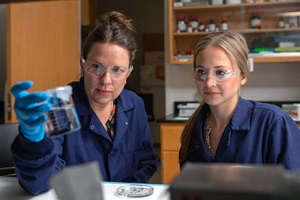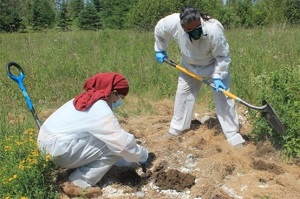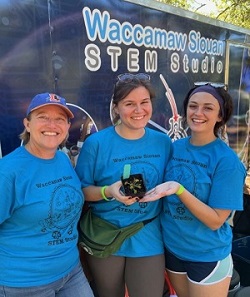Hot Off the Press
E-Factor Stories

Lahey, left, with Anicah Smith, one of the undergraduates Lahey mentored as an SRP trainee. (Photo courtesy of Molly Frazar Lahey)
Improving PFAS Filters with Charged Molecules
Electrically charging certain filtration materials can increase their ability to remove PFAS from water, according to Molly Frazar Lahey, Ph.D. The former University of Kentucky SRP Center trainee spoke about her doctoral research and unexpected career trajectory during the April 15 Karen Wetterhahn Memorial Award Lecture held virtually.
Extramural Paper of the Month: Interaction of Toxic Metals in the Digestive System Revealed
Researchers at the University of Arizona SRP Center revealed how arsenic and cadmium may interact inside the human body, potentially altering their toxicity. The two metals frequently occur together in contaminated soil, but little is known about how combined exposure may affect health.
Extramural Paper of the Month: Prenatal Exposure to Glyphosate Linked to Neurodevelopmental Delays
Researchers from the Northeastern SRP Center found that glyphosate exposure during pregnancy may alter early brain development in children. According to the authors, this is one of the first studies to examine the relationship between exposure to the common herbicide before birth and neurodevelopment in young children.
Extramural Paper of the Month: Sorbent Materials Decrease Movement and Toxicity of PFAS in Soil
A strategy developed by scientists at the Texas A&M University SRP Center may trap PFAS in soil and prevent the chemicals from spreading to plants or water. Immobilizing the chemicals in soil is one remediation strategy to reduce human exposure.

Community members plant fiber hemp, which absorbs PFAS from soil and water and prevents the contamination from spreading. (Image courtesy of Upland Grassroots)
Researchers Team Up with Tribe, Community to Fight PFAS with Plants
Supported by SRP, scientists at Yale University and the Connecticut Agricultural Experiment Station work together with community and tribal members to use hemp plants to remove PFAS from a contaminated site in northern Maine.
Data Science Event Showcases New Approaches to Environmental Health
Researchers and big data specialists from across the country, including NIEHS grantees, gathered at North Carolina State University (NC State) on April 5 for the Data Science and Environmental Health Science Research Symposium. Sponsored in part by the NC State SRP Center, the event was designed to foster collaborative discussion and present cutting-edge work in the field of data science.
Researchers at the University of Iowa SRP Center used biochar, a carbon-rich byproduct of burning plant matter, and bacteria to clean up polychlorinated biphenyls (PCBs) in aquatic environments.
Extramural Paper of the Month: New Strategy to Prioritize PFAS for Health Risk Assessments
A new approach might help scientists better prioritize which PFAS, a large class of compounds linked to negative health outcomes, should be included in health risk assessments, according to researchers at the Texas A&M University SRP Center.
News Stories
SRP Centers Partner to Address PCB Concerns
Researchers at the University of Iowa and the NC State SRP centers partnered to address community concerns about PCBs discovered in an NC State building. During an online forum on February 24, the team answered questions from the NC State community about the health effects of PCBs. Following the session, the team created and shared a document summarizing what was discussed.

From left to right, Elizabeth Shapiro-Garza (Duke SRP), Ph.D., Lacey Brown (North Carolina State University), and Chiara Klein (Duke SRP), at the Waccamaw Siouan STEM Day. (Photo courtesy of Duke SRP)
Duke SRP Center Promotes Garden Safety
Researchers at the Duke University SRP Center are using outreach and community-engaged research to help North Carolina residents identify, understand, and manage risks related to soil contamination. Duke SRP Center staff also developed a variety of tools to help residents identify contaminant sources near their gardens.
SRP Staff and SRP-funded scientists and trainees recently attended the 63rd Annual Meeting and ToxExpo for the Society of Toxicology (SOT), held March 10-14 in Salt Lake City. SRP Health Scientist Administrator Danielle Carlin, Ph.D., co-hosted sessions that provided multiple perspectives on the NIH grant process, as well as advice for new applicants.
Research Briefs
High Seafood Diet May Lead to Increased PFAS Exposure
Consuming some types of commercial seafood in high quantities may increase the risk of PFAS exposure, according to a study funded by an SRP time sensitive research grant. The research team at Dartmouth College believes their findings can support the development of consumption guidelines to protect communities from further PFAS exposure.
Engineering Hydrogel Beads to Enhance Bioremediation of Groundwater Contaminants
Oregon State University SRP Center scientists and engineers developed an approach to cleaning polluted groundwater that uses tiny beads containing chemical-eating bacteria. The team identified a formula to maximize bead durability and bioremediation, or the removal of contaminants using bacteria.
Tracking Mercury Conversion and Distribution in Aquatic Environments
Researchers led by Heileen Hsu-Kim, Ph.D., at Duke University, provided insight into how and at what timescale mercury changes within a wetland ecosystem. They found mercury from different sources is converted into other mercury forms that eventually have similar properties, which can inform environmental management strategies.
Hot Publications
Check out our Hot Publications page to see brief summaries of papers that have been featured in the monthly e-Posted Notes newsletter!
to Top



